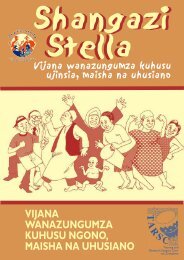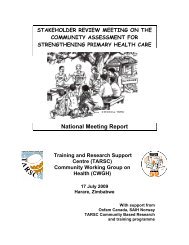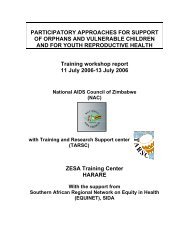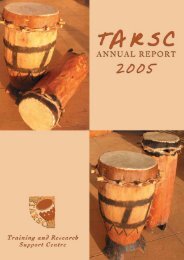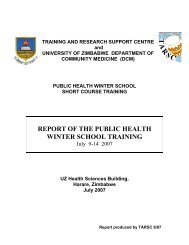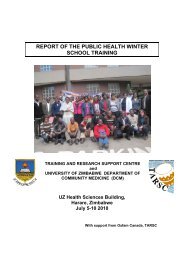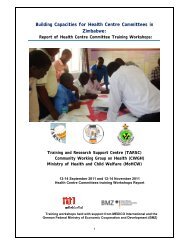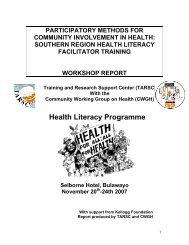BEAM rep final.pdf - Training and Research Support Centre
BEAM rep final.pdf - Training and Research Support Centre
BEAM rep final.pdf - Training and Research Support Centre
Create successful ePaper yourself
Turn your PDF publications into a flip-book with our unique Google optimized e-Paper software.
Table 16: Criteria for Continued <strong>BEAM</strong> Assistance<br />
Type of School<br />
Is continued <strong>BEAM</strong> assistance tied to:<br />
Performance Need I do not know<br />
Government (n=38) 0.0% 100% 0%<br />
Council (n=120) 1.7% 88.1% 10.2%<br />
Mission (n=20) 0.0% 95.5% 4.5%<br />
Estate/Other (n=10) 10.0% 90.0% 0%<br />
Total (n=118) 1.6% 91.5% 6.9%<br />
About 30% of beneficiaries <strong>rep</strong>orted failing to access <strong>BEAM</strong> funds at some stage in their<br />
studies, with the majority of cases happening at council, mission <strong>and</strong> Estate schools. The study<br />
could not determine whether there was prioritisation in terms of disbursement of funds between<br />
the different school types <strong>and</strong> different school locations. Government policy on non-payment of<br />
fees, specifically for the beneficiaries stated that beneficiaries should not be excluded from<br />
classes for non-payment or delays in payment of fees, since the funds would be disbursed<br />
anyway. However, while the government schools did not have any cases where beneficiaries<br />
were barred from attending school on account of non-payment of fees, council schools, mission<br />
<strong>and</strong> estate schools had about 10% of cases where beneficiaries were excluded from school for<br />
non-payment. Council <strong>and</strong> mission schools were not strictly obliged to adhere to the<br />
government policy of not sending away pupils for non-payment of fees. Estate schools had a<br />
greater share of pupils who were excluded from school for non-payment, simply because the<br />
Estates have a tendency of using child labour <strong>and</strong> often offer these beneficiaries work on the<br />
farm in exchange for payment of schools fees.<br />
Table 17: <strong>BEAM</strong> beneficiaries <strong>and</strong> Non-payment of Fees<br />
Type of school<br />
Has the <strong>BEAM</strong> at any period failed to<br />
pay for your fees/levies?<br />
Are you sometimes chased from school for non<br />
payment of fees <strong>and</strong> levies?<br />
Yes No Yes No<br />
Government (n=38) 2.6% 97.4% 0% 100%<br />
Council (n=119) 12.6% 87.4% 10% 90%<br />
Mission (n=22) 22.7% 77.3% 18.2% 81.8%<br />
Estate/Other (n=10) 30.0% 70.0% 30.0% 70.0%<br />
Location of School<br />
Urban 7.5% 92.5% 7.5% 92.5%<br />
Rural 15.4% 84.6% 12.0% 88.0%<br />
Resettlement 3.8% 4.8% 0% 100%<br />
Estates/other 33.3% 66.7% 44.4% 55.6%<br />
Total (n=189) 13.8% 86.2% 10% 90.0%<br />
3.4 Selection Committee, Accountability <strong>and</strong> Governance Issues<br />
We interviewed 85 members of the school selection committee who were neither the<br />
Headmaster of the school nor the community head, to get a view from an ordinary member of<br />
the committee. About 81.2% of the surveyed committee members affirmed that most of their<br />
peers in the school selection committees had a good to a very good underst<strong>and</strong>ing of the <strong>BEAM</strong><br />
guidelines on selection of beneficiaries.<br />
About 38.1% of those interviewed observed that schools did not display lists of beneficiary on<br />
the public notice board. The display of names on the public notice allows the community to<br />
verify who has beneficiated <strong>and</strong> to even question the basis for the allocation of support. Without<br />
a publicly available list of beneficiaries, transparency <strong>and</strong> accountability could be compromised.<br />
18



